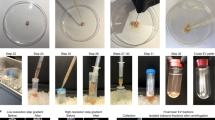Abstract
CHO and Grieg1 reported that 14-nm virus-like particles could be extracted from the brains of mice in the late clinical stage of scrapie but not from the brains of young, uninoculated mice. The extraction procedure involved repeated fluorocarbon treatment followed by equilibrium banding on CsCl gradients. One band was obtained from extracts of normal brain at a density of 1.29–1.30 g cm−3 and two bands were obtained from scrapie brain extracts at densities of 1.29–1.30 g cm−3 and 1.33–1.34 g cm−3, respectively. Electron microscope studies showed that 14-nm particles were found mainly in the 1.33–1.34 g cm−3 fraction derived from scrapie brains. It was subsequently reported2 that similar particles could be obtained at the same density after centrifuging extracts of scrapie hamster brain. This second study also showed that the exhaustive extraction procedure resulted in a large loss of infectivity, but the small amount of infectivity remaining sedimented mainly in the same position as the 14-nm particles. From these observations it was suggested that the 14-nm particles might be the causative agent of scrapie. Similar studies have been carried out at Compton during the last year in an attempt to repeat these findings with brain both from mice in the late clinical stage of infection and from sheep with natural scrapie. In none of these studies was a visible band seen at 1.33–1.34 g cm−3 after isopycnic centrifugation in CsCl. Electron microscopy studies of this fraction derived from scrapie mice showed 14-nm particles, resembling those originally reported, in one field only; the sample was rich in other particulate material common to control samples also. In order to resolve these different findings a collaborative study was arranged at Lethbridge in which scrapie mouse brain and brains of age-matched control mice (previously injected with normal mouse brain) from both Institutes were extracted. We report here that 14-nm particles can be visualised from both control and scrapie-affected mouse brain.
This is a preview of subscription content, access via your institution
Access options
Subscribe to this journal
Receive 51 print issues and online access
$199.00 per year
only $3.90 per issue
Buy this article
- Purchase on Springer Link
- Instant access to full article PDF
Prices may be subject to local taxes which are calculated during checkout
Similar content being viewed by others
References
Cho, H. J. & Greig, A. S. Nature 257, 685–686 (1975).
Cho, H. J. Nature 262, 411–412 (1976).
Eklund, C. M., Kennedy, R. C. & Hadlow, W. J. J. infect. Dis. 117, 15–22 (1967).
Chandler, R. L. Res. vet. Sci. 4, 276–285 (1963).
Author information
Authors and Affiliations
Rights and permissions
About this article
Cite this article
CHO, H., GREIG, A., CORP, C. et al. Virus-like particles from both control and scrapie-affected mouse brain. Nature 267, 459–460 (1977). https://doi.org/10.1038/267459a0
Received:
Accepted:
Issue Date:
DOI: https://doi.org/10.1038/267459a0
This article is cited by
-
Scrapie in the sheep and laboratory animals: Suitability of the sheep model for the study of slow virus diseases
Veterinary Science Communications (1979)
Comments
By submitting a comment you agree to abide by our Terms and Community Guidelines. If you find something abusive or that does not comply with our terms or guidelines please flag it as inappropriate.



